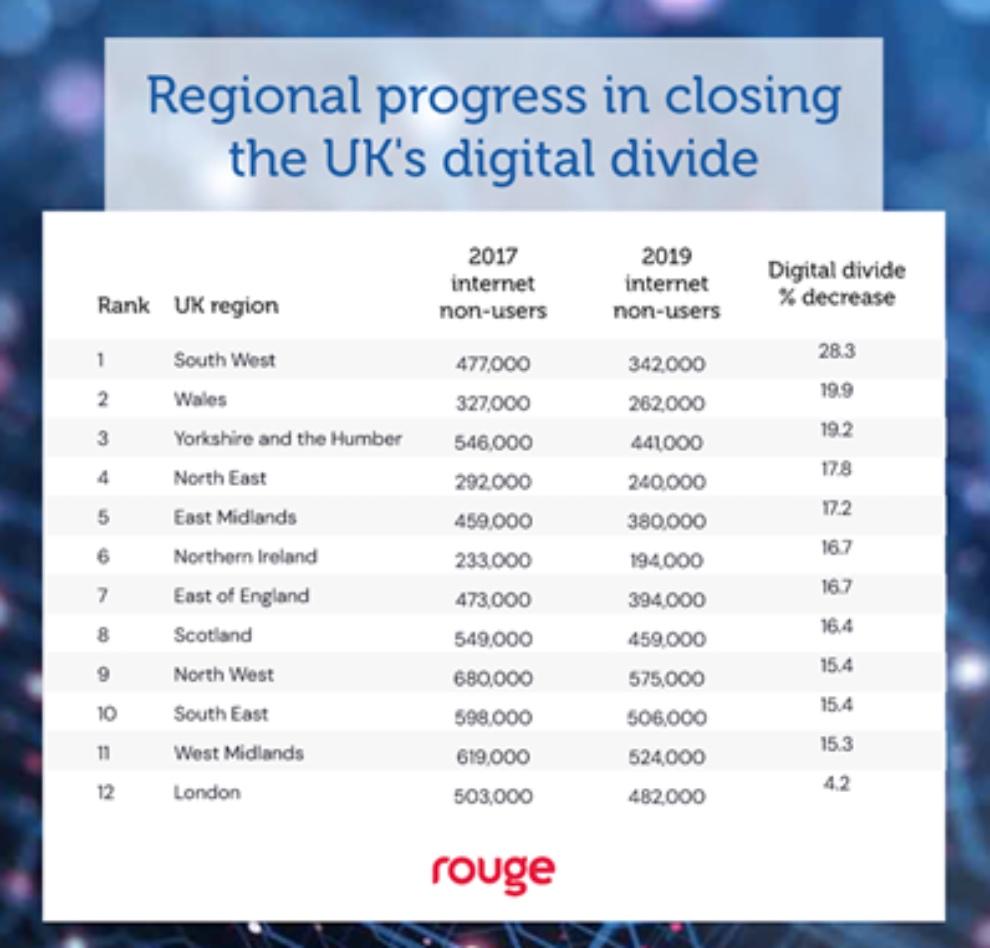
South West the only UK region to hit government target in closing its digital divide
Exclusive data analysis by web design and development agency Rouge Media reveals the South West has made the strongest progress in closing its digital divide, exceeding official targets.
In the UK Government’s 2014 “Digital Inclusion Strategy”, the target was set to reduce the number of people offline by 25 percent every 2 years. And by the end of 2020, everyone who can be digitally capable, will be.
However, new analysis of the latest data shows between 2017 and 2019, this target was missed in every UK region except the South West which closed by an impressive 28 percent.
This brings the number of internet non-users down from 477,00 people in 2017 to an estimated 342,000 people in 2019. That means 7.6 percent of the region’s population over the age of 16 does not use the internet.
Every other region in the UK underperformed when compared against the official target:

Over recent years, there’s been a growing focus on so-called “internet non-users” as part of the debate about the digital divide and its impact on inclusion. And the COVID-19 pandemic has exposed the digital divide like never before, as the physical world moved online.
Of all locations in the South West, Dorset ranks highest for the percentage of residents who don’t use the internet: in 2019, 9.8 percent of Dorset citizens were classed as internet non-users, ranking the county 60th in the UK.
However, Cornwall and the Isles of Scilly have seen a large reduction in their percentage of internet non-users, with an 8.6 percent decrease from 17.6 percent in 2017 to 9 percent in 2019. This a clear step in the right direction.
A £250 million project to improve broadband in the South West began in late 2019 and has been rolling out throughout 2020. This was anticipated to increase internet speed to 20 times the average UK figure, and may encourage even more people in the South West to get started online, closing the digital divide even further.
By contrast, London has seen the slowest progress in closing its digital divide, with the number of internet non-users (aged 16+) only falling by 4 percent in the last two-year period. This means there’s still an estimated 482,000 Londoners who live offline.
However, London has the lowest percentage of internet non-users in the UK based on its population size. In 2019, 6.8 percent of its residents were offline.
One of the factors influencing London’s smaller digital divide is its population is comparatively young; the average age in London is 35.6, compared to 40.3 in the UK overall. In Inner London, almost half the population is in their early twenties to early forties (46.7 percent), compared to 30.9 percent in the rest of England.
Northern Ireland has the highest proportion of internet non-users - 13.2 percent or 194,000 people. It has also only achieved a 16.7 percent reduction in its digital divide between 2017 and 2019 - much lower than the official target.
According to the Centre for Economics and Business Research (CEBR), individuals with basic digital skills are able to benefit from 3-10 percent higher earnings; lower unemployment, cheaper shopping; more frequent social contact, and time-savings when accessing vital services than people with no digital skills.
As the portion of the population who were born before the internet becomes smaller and the first generation of “digital natives” reach adulthood, the digital divide will close further and at an accelerated rate.
However, enduring social and economic issues will remain, preventing people from using or benefiting from the internet fully.
You can read more about the study and explore the findings on an interactive map here.
Andy Woods, Director of Rouge Media commented on the findings: “It’s been really interesting to study the progress being made to meet the UK Government’s ambitious target of getting everyone who’s digital capable online by the end of 2020. It’s clear that while positive work has been done, an enduring digital divide remains.
“Internet costs have been rising steadily over recent years, while speed and reliability are still major issues affecting many regions. Until the UK’s digital infrastructure is fit for purpose nationwide, we won’t be able to unlock the full social and economic potential and make greater strides in addressing the inequalities that remain”.











